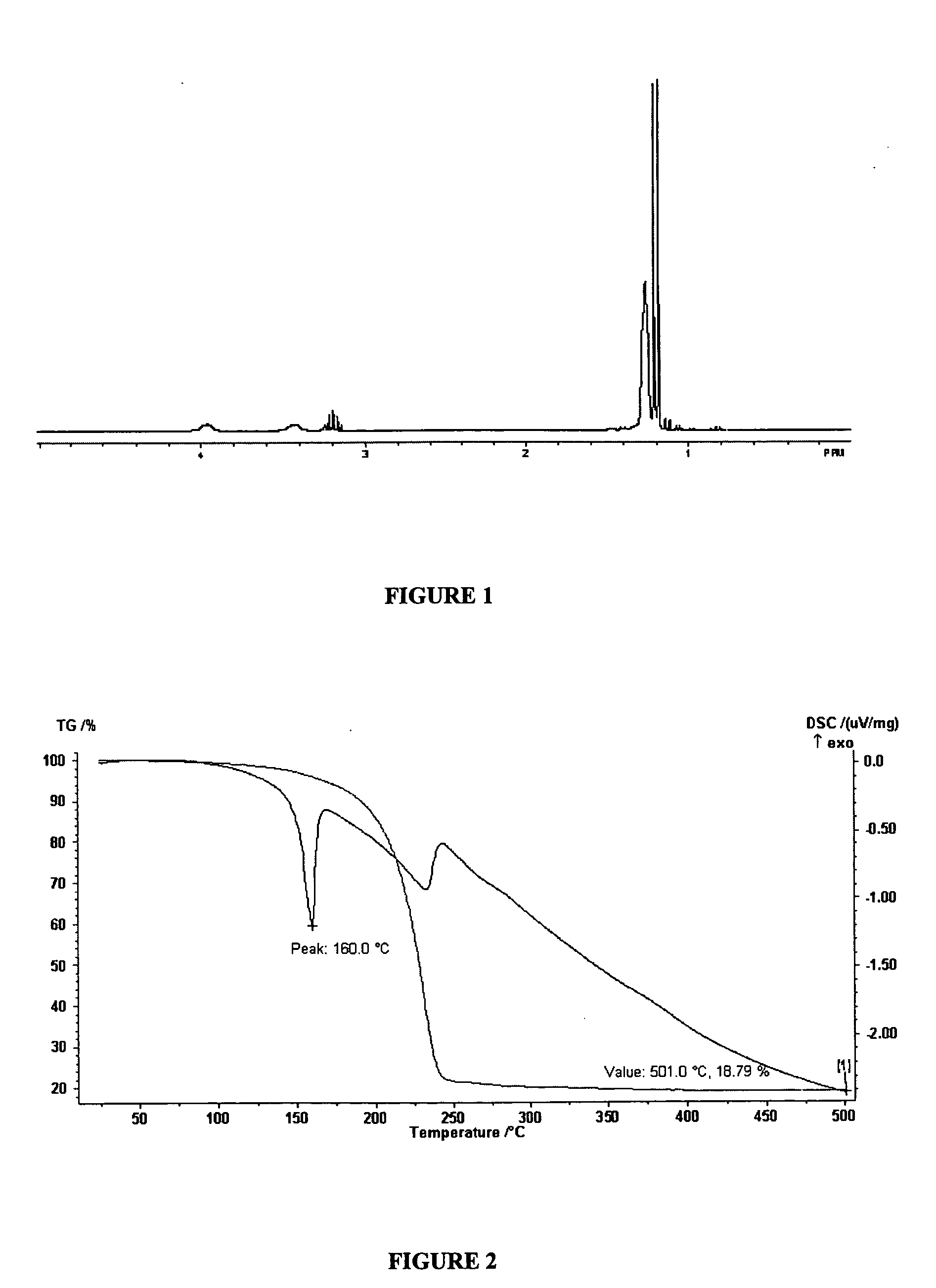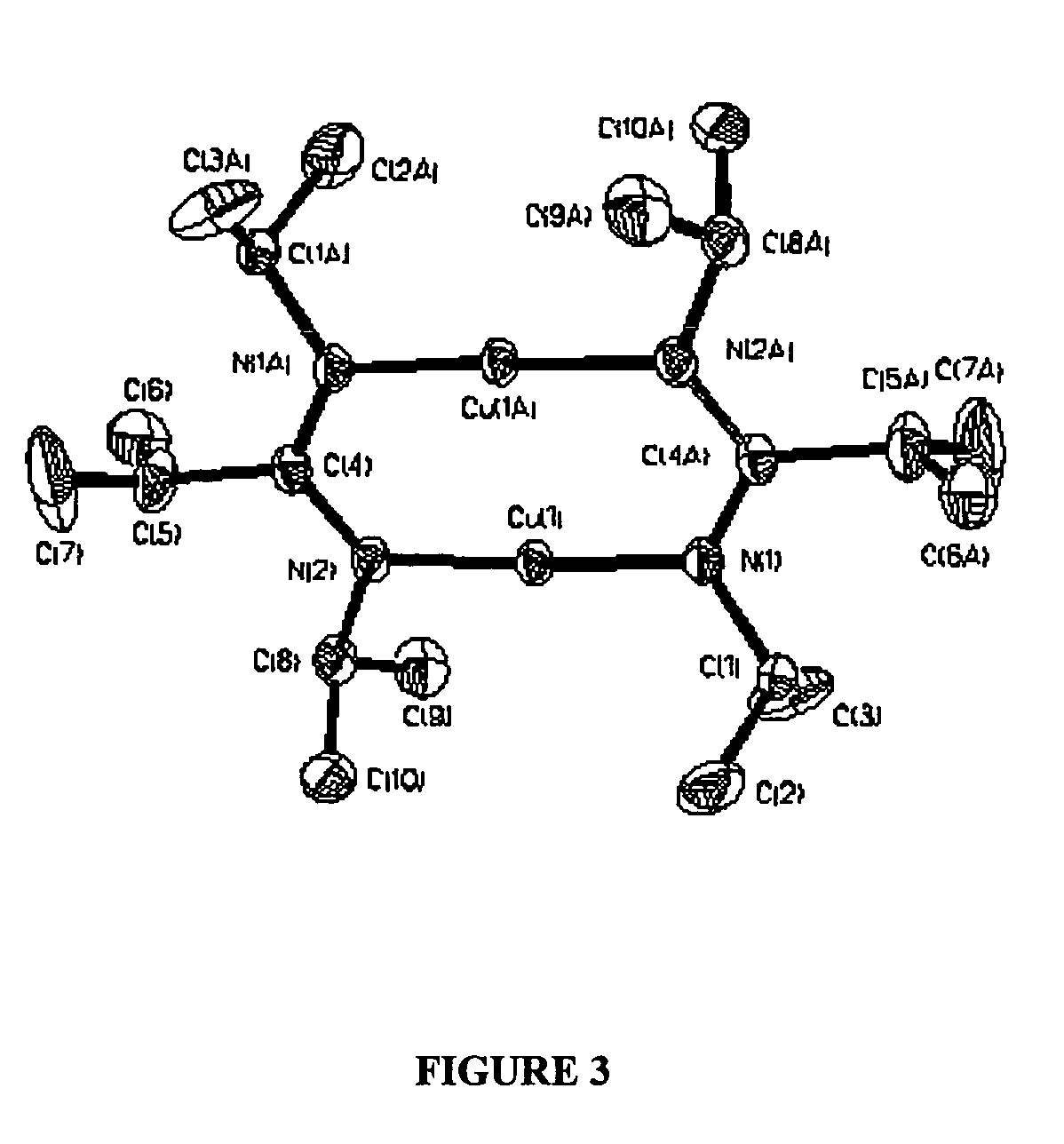Copper (I) compounds useful as deposition precursors of copper thin films
a technology of copper and precursors, applied in the field of new copper (i) amidinates, can solve the problems of poor adhesion of metallization and high contact resistance, and achieve the effect of improving adhesion
- Summary
- Abstract
- Description
- Claims
- Application Information
AI Technical Summary
Benefits of technology
Problems solved by technology
Method used
Image
Examples
example 1
Synthesis of copper (I) 2-isopropyl-1,3-diisopropylamidinate
[0045] The reaction was carried out under a steady flow of nitrogen. A Schlenk flask was charged with 6.3 g of 1,3-diisopropylcarbodiimide ((CH3)2CHN═C=NCH(CH3), 49.9 mmol) and 50 mL dry ether and placed in an ice bath. Then, 32 mL of isopropyllithium (1.6M in ether, 51.2 mmol) was added dropwise to the magnetically stirred mixture at about 0° C. After the addition was complete, the mixture was stirred at room temperature for two additional hours. The mixture was transferred to another flask containing 6 g of CuCl (60.6 mmol) suspended in 50 mL ether. This mixture was stirred at room temperature overnight and then stripped to dryness. The solid residue was extracted with pentane (3×50 mL). After extraction, the pentane filtrate was concentrated to slightly cloudy. The saturated solution was placed in a freezer at −39° C., and crystalline product was obtained in a yield of about 60%.
[0046]FIG. 1 shows the 1H NMR (C6D6) fo...
example 2
Synthesis of copper (I) 2-dimethylamino-1,3-diisopropylamidinate
[0049] Neat 1,3-diisopropylcarbodiimide (12.37 g, 98 mmol, 15.2 mL) was slowly added to a solution of LiNMe2 (5 g, 98 mmol) in 125 mL of THF. Some heat generation was observed. The reaction mixture was stirred for 1 hour. Thereafter, 9.7 g of solid CuCl (98 mmol) was added to the reaction mixture in a dry box. The resulting greenish suspension was stirred overnight and all volatiles were removed in vacuum. The residue was washed in 150 mL of hexane. Filtrate was concentrated in vacuum and placed in a refrigerator whereby neat crystals grew overnight. The overall yield was 60% and the melting point of the crystals was 108° C. 1H NMR (C6D6): δ 3.42 (septet, 1H, J(H—H)=6 Hz, CH(CH3)2), 2.55 (singlet, 3H, N(CH3)2), 1.30 (doublet, 6H, J(H—H)=6 Hz, CH(CH3)2). 13C NMR (C6D6): δ 171.95 (Me2NC(N(iPr))2), 48.61 (CH(CH3)2), 41.29 (N(CH3)2), 27.98 (CH(CH3)2).
[0050]FIG. 4 shows the STA / DSC plot for copper (I) 2-dimethylamino-1,3-...
PUM
| Property | Measurement | Unit |
|---|---|---|
| temperature | aaaaa | aaaaa |
| temperature | aaaaa | aaaaa |
| temperature | aaaaa | aaaaa |
Abstract
Description
Claims
Application Information
 Login to View More
Login to View More - R&D
- Intellectual Property
- Life Sciences
- Materials
- Tech Scout
- Unparalleled Data Quality
- Higher Quality Content
- 60% Fewer Hallucinations
Browse by: Latest US Patents, China's latest patents, Technical Efficacy Thesaurus, Application Domain, Technology Topic, Popular Technical Reports.
© 2025 PatSnap. All rights reserved.Legal|Privacy policy|Modern Slavery Act Transparency Statement|Sitemap|About US| Contact US: help@patsnap.com



